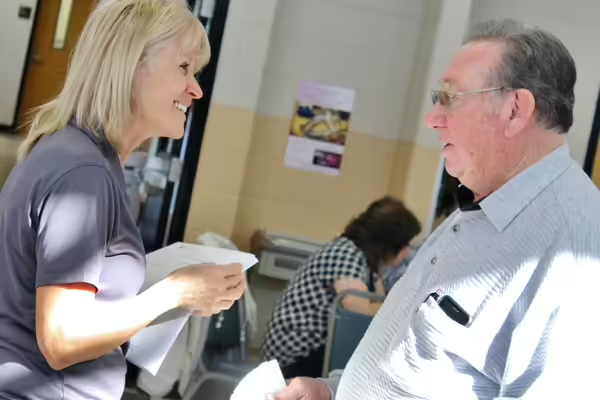
URBANA, Ill. – The aging American population faces a difficult-to-identify and often overlooked challenge — malnutrition. However, University of Illinois Extension is working with other organizations to combat this growing threat to the health of older residents in Illinois.
Around half of older adults either are at risk of becoming malnourished or are malnourished, according to the Defeat Malnutrition Today Coalition. With the number of Americans age 65 and older making up more than 15 percent of our population in 2016, the number of at-risk older adults is expected to rise as the Baby Boomer generation ages.
“As Americans live longer, malnutrition is likely to grow with it,” said Laura Barr, University of Illinois Extension nutrition and wellness educator. “As we age, our bodies need fewer calories, but have the same nutritional needs. Additionally, we are less active, and thirst and hunger cues are not as strong as they once were, increasing the risk of poor nutrition.”
Those at greatest risk are age 80 and older or who have already been diagnosed with chronic disease.
“Poor nutrition in older adults can worsen chronic diseases and can delay healing and increase chances of infection or falls,” Barr said. “It can be caused by or exasperated by chewing or swallowing problems, lack of transportation or support systems, medication interactions and being on a fixed income.”
“Malnourished seniors are not necessarily those struggling with food insecurity,” said Ginnie Moore, Community Planner and Health educator with Northeastern Illinois Area Agency on Aging. “They may be facing another challenge.”
For example, a senior who lives alone and has arthritis may struggle with meal preparation. As a result, he or she may opt for more easy-to-fix microwave meals that are high in sodium while being lower in other important vitamins and minerals.
Complicating things further, some older adults may experience weight loss with malnutrition.
“Many times it is not that they are underweight, but that they are consuming low-nutrient foods or highly-processed, convenient foods that result in limited nutrition,” said Sandy Pastore, executive director of the Oswego Senior Center. She also adds that this loss of nutrients affects overall health, as well as energy, motivation, and cognitive function.
“We collaborate with U of I Extension to develop and provide education and application opportunities,” said Pastore. “We partner to teach nutrition basics, balanced eating, healthy choices while eating out, budget friendly nutrition, diabetic and heart healthy diets, and more.”
Seniors also may face emotional barriers to nutrition.
“Eating alone is one of the biggest risk factors, as 42.3 percent of Illinois seniors live by themselves,” added Pastore. “When eating alone, individuals may not be motivated to cook a balanced meal and may typically eat convenient foods that are low in nutrients and high in sodium.”
Barr recommends older adults find congregate meal sites, like senior centers, park districts, places of worship, and other organizations that not only serve nutritious food but they also help combat isolation or loneliness.
“It provides a balanced, nutritious, and delicious lunch in a setting where peers eat and interact with each other,” said Pastore. “They build connections and community through breaking bread together.”
According to the latest Illinois Department on Aging statistics, 81,545 Illinois seniors were served through congregate meal sites in 2014, and another 33,930 were served through home-delivered meals in Illinois.
“Both programs offer a great opportunity to help prevent senior malnutrition,” said Moore. “Community dining meals[HCA1] allow older adults to engage in a welcoming environment with fellow community members. Home-delivered meals provide homebound older adults with a daily well-being check and a few moments of friendly conversation.”
All meals provided through these programs supply at least one-third of the daily nutrition needs of the average older adult. The Older American Act provides partial funding for both programs for adults age 60 and older, and donations are suggested to help cover the cost of the meals although no one is ever turned away because they cannot or are unable to donate.
In addition to meal options, educational opportunities and social activities can help.
“It is important to encourage healthy eating habits for our seniors, as well as keep them up to date on ways to continue healthy habits on a day-to-day basis,” said Dannika Young, director of Senior Services, Decatur Macon County Opportunities Corporation. “This will increase their ability to socialize, as well as decrease doctor visits or hospital stays.”
Young and Pastore both partner with their local University of Illinois Extension teams to bring nutrition education to their organization programming.
“We want to help seniors get excited about food and cooking,” Pastore said. “It also is important for people to have accurate and tangible information.”
At Decatur Macon County Opportunities Corporation, Extension supports the daily noontime nutrition program
“They help with preparing the healthy menus, as well as monthly nutritional handouts for our seniors,” said Young. “The handouts can help them continue healthy eating habits beyond our nutritional noon-time meal program.”
Oswego Senior Center also offers interactive classes that include information, discussion, tastings, and cooking.
Together, Extension and its many community and state partners work to provide nutrition education and decrease malnutrition in Illinois communities.
The National Council on Aging recommends six steps for older Americans to prevent malnutrition:
1. Understand malnutrition. Check it out at www.ncoa.org/NutritionTools
2. Make smart food choices. www.ncoa.org/EatWell
3. Try an oral nutritional supplement
4. Take care of your teeth
5. Consult with your health care provider
6. Find help, such as www.MealsonWheelsAmerica.org, BenefitsCheckUp.org/SNAP or www.FeedingAmerica.org/foodbank or call the Illinois Department on Aging at 1-800-252-8966.
TOP PHOTO: Laura Barr, University of Illinios Extension nutrition and wellness educator, talks to a senior at at a nutrition event. Photo by Rosie Raltson.
Illinois Extension leads public outreach for University of Illinois by translating research into action plans that allow Illinois families, businesses, and community leaders to solve problems, make informed decisions, and adapt to changes and opportunities.